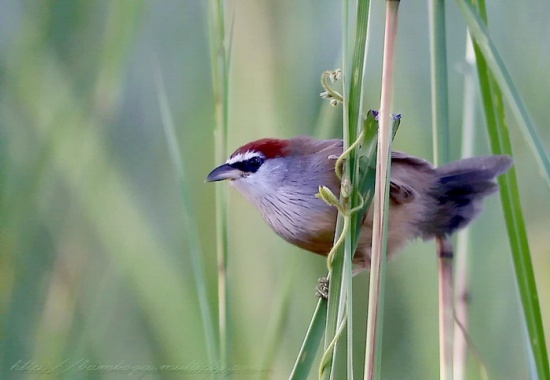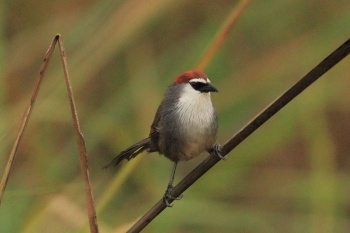Alternative name: Red-capped Babbler
- Timalia pileata
Identification
15.5 - 17cm (6-6¾ in). A medium-sized Babbler:
- Thick black bill
- Chestnut cap
- Black mask
- White supercilium, cheeks, throat and upper breast
- Fine dark streaks over throat and breast
- Grey sides of neck and breast
- Olive-brown upperparts
- Fairly long tail
Sexes are similar but males are larger than females.
Juveniles are warmer brown above, the cap and supercilium are duller and the lower mandible has a pale base.
Distribution
Found from north India east over Nepal, parts of east and northeast India to Bangladesh, Burma, south China, Thailand, Indochina and an isolated population on Java, Indonesia.
Locally common.
Taxonomy
Subspecies
There are 6 subspecies[1]:
- T. p. bengalensis from north India east to Nepal, northeast India, Bangladesh and northwest and west Burma
- T. p. smithi in north and east Burma, northwest Thailand, south China (Yunnan, Guizhou, Guangxi, Guangdong), Laos and north Vietnam
- T. p. intermedia in central and south Burma and west Thailand
- T. p. patriciae in southwest Thailand
- T. p. dictator in northeast and southeast Thailand, Cambodia, south Laos and south Vietnam
- T. p. pileata in west Java
Habitat
Swampy areas, tall grass, reedbeds, brushwood and scrub-jungle, thorn hedges, bamboo between cultivations. Often along streams. Up to 1500m in most of its range, up to 880m in China.
Behaviour
Diet
Feeds on caterpillars, beetles and other insects.
Usually seen in pairs and outside the breeding season in groups of 6 - 8 birds, often together with Yellow-eyed Babbler. Keeps low down in vegetation.
Breeding
Breeding season February to October in India, April to September in southeast Asia. The nest is a rough ball (oval or dome) made of dry coarse grasses, straw, dry bamboo or other leaves. Lays 2 - 5 eggs.
Movements
Resident species.
References
- Clements, J. F., T. S. Schulenberg, M. J. Iliff, D. Roberson, T. A. Fredericks, B. L. Sullivan, and C. L. Wood. 2016. The eBird/Clements checklist of birds of the world: v2016, with updates to August 2016. Downloaded from http://www.birds.cornell.edu/clementschecklist/download/
- Del Hoyo, J, A Elliott, and D Christie, eds. 2007. Handbook of the Birds of the World. Volume 12: Picathartes to Tits and Chickadees. Barcelona: Lynx Edicions. ISBN 978-8496553422
- Rasmussen, PC and JC Anderton. 2005. Birds of South Asia: The Ripley Guide. Barcelona: Lynx Edicions. ISBN 978-8487334672
Recommended Citation
- BirdForum Opus contributors. (2025) Chestnut-capped Babbler. In: BirdForum, the forum for wild birds and birding. Retrieved 12 May 2025 from https://www.birdforum.net/opus/Chestnut-capped_Babbler





